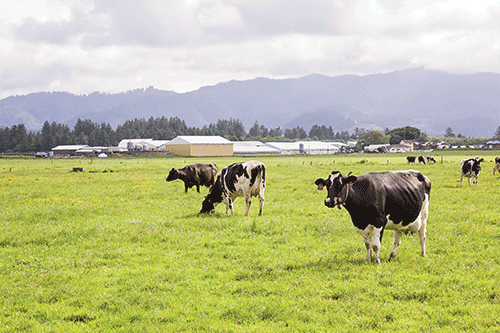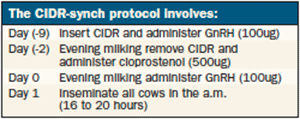The author worked as a veterinarian in New Zealand and is now working in a mixed animal practice in Chapel Hill, Tenn.

Compact calving windows require ciws with adequate body condition,
good uterine health and well-managed synch programs.
Economics govern the profitability of seasonal calving and grazing. One of the fundamental principles is based on our ability to get a grand majority of cows calving in a concentrated window to take advantage of maximum pasture growth. In order to meet this goal, our ability to influence the estrous cycle through timely mating, subsequent calving and peak milk production drive the business structure.
All based on a 12-month calendar
For seasonal grazing operations, we must optimize reproductive performance by maintaining a 12-month calving interval. To reach this goal, we aim to have 50 percent of the herd calve in the first 14 days after the planned start of calving (PSC) and 70 percent calved by four weeks after this target. To optimize this calving pattern, more than 80 percent of cows need to show heat cycles prior to the planned start of mating (PSM). At breeding time, 90 percent of cows need to be submitted for mating during the first three weeks with 100 percent of cows submitted by six weeks.
In order to achieve these targets, graziers need to consider several key factors. It begins with anestrus. It is defined as: cows that are greater than three weeks postpartum but one week before the planned start of mating that have not been detected in estrus and do not have a palpable corpus luteum (CL). Cows in this group generally have challenges with body condition and postparturient uterine health.
Anestrus can be a significant problem in seasonal calving dairy herds since there is often a narrow window between calving and conception. If undetected, this cow becomes a calving pattern outlier which may never recover and fit into the herd's seasonal program. Overall, anestrus is associated with lowered submission, conception and pregnancy rates, as well as a greater probability for being culled due to reproductive failure.
Body condition score (BCS) of cows at calving is probably the most important nutritional and physiological factor associated with getting cows safe in calf. Attention to feeding cows in late lactation, at dry-off and throughout the dry period ensures they reach our BCS targets. Healthy conditioned cows at calving experience a smoother transition to lactation which can help promote good immune function and protection from uterine disease.
Monitoring energy intake and milk production will help confirm that cows are being fed adequately. Lower body condition score cows have a greater likelihood of not ovulating. In fact, herds that have low BCS at 70 days postpartum were likely to have a higher percentage of anovular cows, reported researchers in one grazing-based study.
Track poor doers more closely
Postparturient uterine health is extremely important for early rebreeding. Farmers are encouraged to record any cows that have retained fetal membranes (RFM), had assisted calving, twins or other risk factors for intrauterine infections. In one New Zealand study, cows calved in the 40 days before the planned start of mating had lower submission rates than cows calved greater than 40 days before PSM. Pregnancy rate by 28 days after PSM was lower in cows that had retained fetal membranes, assisted calvings or calved late compared to unaffected herdmates (McDougall 2001).
Assessment of these cows prior to the planned start of mating is encouraged to ensure good uterine health for conception. The impact of clinical endometritis, a sign of poor uterine health, has been found to reduce pregnancy rate by 27 percent (LeBlanc 2003). For example, using this research, a herd's 21-day pregnancy rate would fall from 20 percent to 14.6. More recent observations indicate that the inflammatory process involved with postpartum healing of the uterus may have just as important an impact on uterine fertility as bacterial infections. This suggests that a compact calving window which provides adequate time for involution postpartum is important for overall fertility.
Don't make assumptions
Cows not detected in heat are assumed to be not cycling; however, this is not always true. Cows may not display a standing heat despite normal hormone responses and ovulation. The use of heat detection aids like tail paint and electronic devices have enhanced our ability to identify cows in estrus.
The observation and recording of premating heats is important for planning synchronization programs and to allow cows time to heal naturally through normal return to estrous cycles. Synchronization programs have moved away from estrus to ovulation synchronization which has improved overall conception rates. However, in some instances, the ovsych protocol has not performed well for anestrus cows. This is not unexpected since it was designed for synchronization of ovulation. The reproductive performance of cows could be improved with the addition of progesterone to the program.
El-Zarkouny and his colleagues (2004) found that the CIDR and ovsynch had a greater pregnancy rate at 29 days after timed A.I. than just ovsynch, especially in anestrus cows. On average, they found you get a 20 percent greater pregnancy rate for CIDR-synch versus ovsynch cows.

This program removes the variability associated with heat detection and risks associated with cows displaying estrus activity. Following synchronization, early pregnancy checks need to be done to ensure cows have not returned to estrus due to pregnancy rather than reversion to an anestrus state. In addition, if bulls are being used for breeding, adequate bull power is necessary for days when synchronized cows may be expected to return to estrus or be prepared to perform artificial insemination for a short time period when the synchronized cows are in estrus.
Tighten the window
The success of an intensive pasture-based dairy farm relies on a compact calving window, strategically planned to coincide with peak milk production and peak pasture growth. To ensure a compact calving window, attention to reproductive performance of the herd is critical. Start first with adequate body condition and good uterine health, and follow up with strategic use of synchronization programs to promote a tight calving pattern.
Click here to return to the Reproduction E-Sources 1306_406

good uterine health and well-managed synch programs.
Economics govern the profitability of seasonal calving and grazing. One of the fundamental principles is based on our ability to get a grand majority of cows calving in a concentrated window to take advantage of maximum pasture growth. In order to meet this goal, our ability to influence the estrous cycle through timely mating, subsequent calving and peak milk production drive the business structure.
All based on a 12-month calendar
For seasonal grazing operations, we must optimize reproductive performance by maintaining a 12-month calving interval. To reach this goal, we aim to have 50 percent of the herd calve in the first 14 days after the planned start of calving (PSC) and 70 percent calved by four weeks after this target. To optimize this calving pattern, more than 80 percent of cows need to show heat cycles prior to the planned start of mating (PSM). At breeding time, 90 percent of cows need to be submitted for mating during the first three weeks with 100 percent of cows submitted by six weeks.
In order to achieve these targets, graziers need to consider several key factors. It begins with anestrus. It is defined as: cows that are greater than three weeks postpartum but one week before the planned start of mating that have not been detected in estrus and do not have a palpable corpus luteum (CL). Cows in this group generally have challenges with body condition and postparturient uterine health.
Anestrus can be a significant problem in seasonal calving dairy herds since there is often a narrow window between calving and conception. If undetected, this cow becomes a calving pattern outlier which may never recover and fit into the herd's seasonal program. Overall, anestrus is associated with lowered submission, conception and pregnancy rates, as well as a greater probability for being culled due to reproductive failure.
Body condition score (BCS) of cows at calving is probably the most important nutritional and physiological factor associated with getting cows safe in calf. Attention to feeding cows in late lactation, at dry-off and throughout the dry period ensures they reach our BCS targets. Healthy conditioned cows at calving experience a smoother transition to lactation which can help promote good immune function and protection from uterine disease.
Monitoring energy intake and milk production will help confirm that cows are being fed adequately. Lower body condition score cows have a greater likelihood of not ovulating. In fact, herds that have low BCS at 70 days postpartum were likely to have a higher percentage of anovular cows, reported researchers in one grazing-based study.
Track poor doers more closely
Postparturient uterine health is extremely important for early rebreeding. Farmers are encouraged to record any cows that have retained fetal membranes (RFM), had assisted calving, twins or other risk factors for intrauterine infections. In one New Zealand study, cows calved in the 40 days before the planned start of mating had lower submission rates than cows calved greater than 40 days before PSM. Pregnancy rate by 28 days after PSM was lower in cows that had retained fetal membranes, assisted calvings or calved late compared to unaffected herdmates (McDougall 2001).
Assessment of these cows prior to the planned start of mating is encouraged to ensure good uterine health for conception. The impact of clinical endometritis, a sign of poor uterine health, has been found to reduce pregnancy rate by 27 percent (LeBlanc 2003). For example, using this research, a herd's 21-day pregnancy rate would fall from 20 percent to 14.6. More recent observations indicate that the inflammatory process involved with postpartum healing of the uterus may have just as important an impact on uterine fertility as bacterial infections. This suggests that a compact calving window which provides adequate time for involution postpartum is important for overall fertility.
Don't make assumptions
Cows not detected in heat are assumed to be not cycling; however, this is not always true. Cows may not display a standing heat despite normal hormone responses and ovulation. The use of heat detection aids like tail paint and electronic devices have enhanced our ability to identify cows in estrus.
The observation and recording of premating heats is important for planning synchronization programs and to allow cows time to heal naturally through normal return to estrous cycles. Synchronization programs have moved away from estrus to ovulation synchronization which has improved overall conception rates. However, in some instances, the ovsych protocol has not performed well for anestrus cows. This is not unexpected since it was designed for synchronization of ovulation. The reproductive performance of cows could be improved with the addition of progesterone to the program.
El-Zarkouny and his colleagues (2004) found that the CIDR and ovsynch had a greater pregnancy rate at 29 days after timed A.I. than just ovsynch, especially in anestrus cows. On average, they found you get a 20 percent greater pregnancy rate for CIDR-synch versus ovsynch cows.

This program removes the variability associated with heat detection and risks associated with cows displaying estrus activity. Following synchronization, early pregnancy checks need to be done to ensure cows have not returned to estrus due to pregnancy rather than reversion to an anestrus state. In addition, if bulls are being used for breeding, adequate bull power is necessary for days when synchronized cows may be expected to return to estrus or be prepared to perform artificial insemination for a short time period when the synchronized cows are in estrus.
Tighten the window
The success of an intensive pasture-based dairy farm relies on a compact calving window, strategically planned to coincide with peak milk production and peak pasture growth. To ensure a compact calving window, attention to reproductive performance of the herd is critical. Start first with adequate body condition and good uterine health, and follow up with strategic use of synchronization programs to promote a tight calving pattern.








